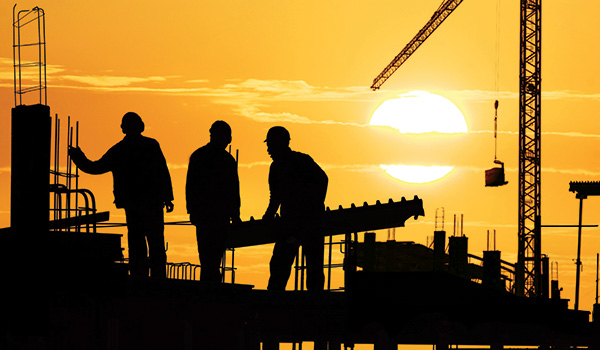 The commercial real estate market was ravaged by the down economy, although it didn’t make disaster headlines like its residential counterpart. There was a day when the metropolitan Phoenix area was tops when it came to building companies expanding and actual construction of commercial projects here in the Valley. Office space, multi-tenant and industrial projects were at all-time highs, but then took such a sharp decline the news was actually the fact that there were, literally, no new projects in our market. Today, the commercial market is showing pockets of strength as it limps into the future.
The commercial real estate market was ravaged by the down economy, although it didn’t make disaster headlines like its residential counterpart. There was a day when the metropolitan Phoenix area was tops when it came to building companies expanding and actual construction of commercial projects here in the Valley. Office space, multi-tenant and industrial projects were at all-time highs, but then took such a sharp decline the news was actually the fact that there were, literally, no new projects in our market. Today, the commercial market is showing pockets of strength as it limps into the future.
Multi-family has been the segment of commercial first to recover. “New construction is dominated by the multi-family market,” says David S. Miller, vice president of national accounts, commercial sales manager with Chicago Title Agency. Jim Swanson, president and CEO of Kitchell Corporation, a Phoenix-based development and construction company, calls multi-family the “development hot spot.”
“On the investment side, multi-family has led the commercial market in sales. We were the first to recover, so it was a safer place to invest,” says David Fogler, executive VP with the multi-housing investment group at real estate brokerage Cassidy Turley’s Phoenix office. While citing 62 projects with a total of 19,000 units in the pipeline — with the caveat that it’s unlikely all of them will ultimately be built — Fogler points out this comes on the heels of an economic downturn that saw many former homeowners foreclosed out of their homes. Home ownership had risen to the unusual high of 70 percent of households, so the drop in homeownership is really just taking it back to normal levels, he explains. However, the bottom line on the current strength of the multi-family market is it’s due to this drop in home ownership rather than to job growth.
Industrial has remained relatively healthy. “Especially on the distribution side,” says Marty Hedlund, senior vice president and Southwest District manager of Tempe-based Sundt Construction, Inc. And Tom Louer, a principal at commercial brokerage Lee & Associates’ Phoenix office, notes there’s a pent-up demand for manufacturing space. “A lot of people have been working in less space and are beginning to grow again.” Smaller companies may find existing space, but, with nine consecutive quarters of positive net absorption, larger companies are looking for buildings to develop.
Compared to other commercial real estate development, industrial projects cost “pennies on the dollar” to build, notes Mike Haenel, executive VP with Cassidy Turley’s industrial group. Haenel expects to see several spec developments in the next 18 to 36 months, building spaces of 250,000 to 1 million square feet. “The confidence [in this growth] is across the board — it’s the landlord, the tenant, the developer, the investor and the broker,” he says.
“Industrial construction activity is dominated by build-to-suits and owner-occupied construction,” says Craig Henig, senior managing director and Arizona Market leader at real estate brokerage CBRE’s Phoenix office. “Build-to-suits represent 70 percent of the square footage under construction at the end of the second quarter.” Examples he cites include Dick’s Sporting Goods (600,000 square feet), Intel (1.2 million square feet) and First Solar (1.2 million square feet) — although, he says, “It is expected the building that was designed for First Solar will not be put on the market due to the change in the renewable energy sector.” Three distribution buildings that broke ground in the second quarter are the 600,000-square-foot Coldwater Depot Logistics Center and two buildings at Elliot Business Park that total 320,000 square feet.
The office market, with an overall vacancy rate of 27 percent, remains weak, as builders can’t compete with lease rates. “Companies are more cautious about growth, rather than running wild and taking excess space,” observes Blake Hastings, senior VP of Cassidy Turley’s office group, noting also the trend to greater efficiency as companies take advantage of technology to reduce the amount of space they need. Law firms, for instance, don’t need large libraries when the reference materials are available online.
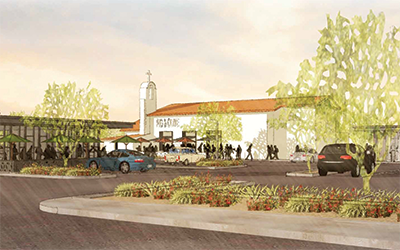
New retail space takes the place of an old church and school at 7th Street and Osborne in Phoenix ©Cassidy Turley
The good news is there are large users in the market that are starting to use up large blocks of space, and Hedlund points out there are not a lot of contiguous spaces greater than 25,000-40,000 square feet. “Larger companies drive the potential for new buildings because they can’t get enough space in one building.”
In general office, construction at this time is limited to one 92,000-square-foot building at Allred Park Place in Chandler’s Price Road Corridor, according to Henig. “The talk of office development at Hayden Ferry in Tempe and in Downtown Phoenix is increasing,” he says, noting several projects are currently going through the pre-development stages.
There is some life in the medical office component of the office market, according to John Strittmatter, president of the Southwest Division of builder and developer Ryan Companies, who says Ryan is starting to see some activity on land it has around the Valley.
Building for healthcare businesses is one of the stronger areas of commercial construction right now, observes Swanson, who says Kitchell is working with healthcare clients on different delivery methods, including community-based medicine. “There are a lot of good [healthcare] systems in town, and they’ll be looking at how to expand and how to deliver healthcare into the 21st century.”
Pockets of Activity
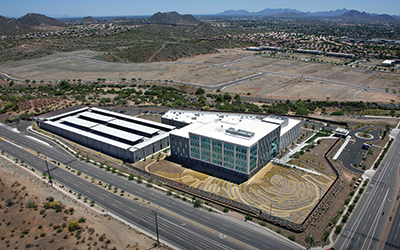
One of few Arizona projects in Ryan Companies’ niche of corporate headquarters is the recently completed FBI Headquarters in north Phoenix ©Ryan Companies
“Retail construction is dominated by the outlet malls at Westgate City Center by Tanger and Simon’s outlet mall in Chandler,” says CBRE’s Henig.
But the general trend is away from power center development, especially on the outlying perimeter, in favor of infill development or redevelopment in already densely populated areas. Says Brad Douglass, of Cassidy Turley’s retail group, “Retailers are getting excited about something they’ve never seen before: this opportunity … where population already exists and we know we can make these projects work, as opposed to out in the middle of nowhere where they’re begging people to come.”
Citing Central Phoenix and Scottsdale as the areas with the healthiest demographic and greatest density, Douglass notes the City of Phoenix is “receptive to incentivizing redevelopment” as part of a big trend called “adaptive reuse.” At 7th Street and Osborne in Phoenix, retail space now stands where there previously was an old church and school. Where previously had been a run-down golf course at Northern and 22nd avenues, there is retail now on the Northern Avenue frontage.
A concurrent trend is for older, big-box centers with high vacancy rates to be redeveloped as multi-family projects, such as happened to the Pure Fitness building at Scottsdale Road and Curry Avenue in Tempe, notes Ryan Leavitt, Douglass’s colleague in Cassidy Turley’s retail group.
For Ryan Companies, all of its construction activity in the retail realm is for a single client — Target — with remodels at 16 of its stores but only one new store, in Chandler.
Activity in the industrial segment is strongest on the west side of the Valley, where, says Strittmatter, “folks are talking about or actually starting spec.” With options limited for spaces of 300,000 square feet or more, interest in big boxes has grown “much quicker than anyone ever thought would happen.”
Proximity to the ports and the Southern California markets makes the area stretching west from Downtown Phoenix along Interstate 10 attractive for future development, especially on the distribution side of industrial, notes Henig. And Haenel, focused on industrial for Cassidy Turley, is finding the Sky Harbor area as well as the Southeast Valley to be active for leasing and developers buying for spec.
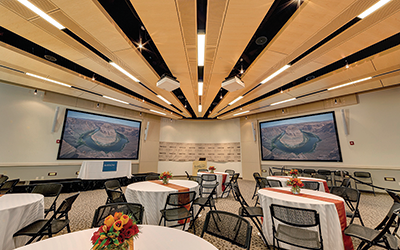
The 3,000-square-foot Sonntag Academic Pavilion at St. Joseph’s Hospital and Medical Center designed by Orcutt/Winslow opened in February 2012 ©Kitchell
The Southeast Valley is also the hottest market for land, according to Will French, of Cassidy Turley’s land group. Says his colleague Brian Rosella, “The biggest driver is homebuilders, due to a lack of supply in the resale market.” In the past six months, according to Rosella, the market for land has gotten overheated, prompting homebuilder companies to go to areas that weren’t viable before. In Gilbert, permits for housing starts nearly doubled this year over last year. “On finished lots, the pricing has gotten crazy, going from $35,000-$40,000 to more than $100,000,” says French, noting the companies are looking at raw farming land to take through the process themselves.
For multi-family development, Chicago Title’s Miller sees most activity in Scottsdale, the southeast and northeast parts of the Valley and far north-central Phoenix, with very little in the far west. And Cassidy Turley’s Fogler notes a heavier concentrated along the Loop 101.
The office market, Henig reports, has seen very good leasing activity around Sky Harbor due to the availability of large blocks of space. For new construction, Sundt’s Hedlund expects the Camelback corridor to be in the first wave of building as the vacancy rates there are among the Valley’s lowest.
Scottsdale has, historically, been the hottest submarket for office, according to Cassidy Turley’s Hastings. Tempe is also strong, particularly Mill Avenue because of its proximity to Arizona State University, although, he notes, “It’s small, so it doesn’t take much to fill up.” These two and Chandler — with a lot of customer-support call centers, the Intel fabrication plant and the only building in the segment currently under construction (tenant-driven construction of a 92,000-square-foot building for Infusionsoft) — Hastings sees as the best office submarkets.
Activity in Downtown Phoenix, with its vacancy rate of 27 percent, is “musical chairs,” says Hastings. “No one is headed to Downtown Phoenix from other submarkets.”
Profile of the Players
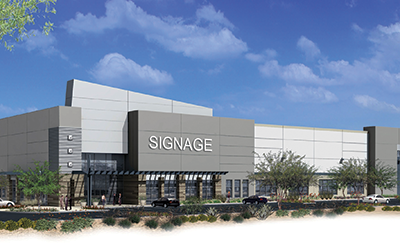
New industrial construction includes the 600,000-square-foot Coldwater Depot Logistics Center underway in central Phoenix ©CBRE
The majority of building is user-driven, primarily due to companies moving or expanding into Arizona, observes Chicago Title’s Miller, who offers a perspective from an industry involved in the acquisition and the development of every real property transaction. Speaking for the industrial market, Haenel says Cassidy Turley is tracking more than 10 million square feet of projects it deems actually viable prospects that are looking to expand or relocate to Phoenix — the majority being relocations from other parts of the country.
“Some of the sectors of note,” says CBRE’s Henig, “are advanced business services, R&D firms, educational, data center, healthcare, e-commerce, financial institutions, insurance companies and technology firms.”
Phoenix ranks in the top 10 nationally for the data center market of mission-critical facilities, thanks to its geographic situation being out of the line of fire of major natural disasters such as hurricanes and earthquakes. While that market is not “bowling things over,” says Sundt’s Hedlund, “there’s a lot of talk and some activity.”
Hedlund also sees continued growth for the universities. Speaking of a general consensus that building an economy that supports growth in Arizona requires high-tech, white-collar and high-education-level jobs which, in turn, requires a robust education system, Hedlund says, “Spending on the universities is one way to help get there, so we think that’s going to continue.”
It’s local people who have the land and know the community who are ultimately behind development, observes Kitchell’s Swanson. “They’ll go out and find the users they want.”
Redevelopment, especially, owes activity to local investors who see a need in the marketplace and an opportunity to capture that need, for instance driving by an old building or vacant lot and imagining it as something else, says Cassidy Turley’s retail specialist Leavitt.
Finding the Funding
With the strength of the multi-family market, the investment side is also very active. Most of this is private, such as real estate investment trusts (REITs), and institutional, rather than individuals or exchanges, says Cassidy Turley’s multi-family expert Fogler. Financing for the equity portion, however, is difficult to obtain. “All developers are competing for a small pool of equity financing, so [funders] are very selective.” It’s the reverse of what the market saw in 2005, when there was more money than projects, he notes, adding, “It will be years before the pendulum swings back to that.”
Speaking for the office side, Strittmatter says financing can be found for projects with at least 50 percent pre-leasing. “Lenders will not provide major financing with major speculative space.” Ryan Companies purchases the land outright on its development projects and then uses that equity to secure construction loans. “We have relationships that span 60 years with US Bank, Wells Fargo Bank and others, but it’s always contingent on pre-leasing,” he notes.
CBRE’s Henig, with an industry-wide view, supports that assessment. “Buyers of all sizes of commercial properties are mostly closing all cash and financing after their purchase,” he says. “The equity is raised through a variety of sources — from private investors with cash from previous investment sales to money raises through a REIT structure or funds with institutional allocations.” He notes that ample capital and competitive terms are available for all property types, for deals that fit the lenders’ criteria.
As Kitchell’s Swanson puts it, “Now more than ever, it’s available for good, well-thought-out projects that have the right amount of equity in them.” There’s a great deal of variety as to sources. A lot of Kitchell’s traditional construction is funded through lending institutions, but Swanson sees healthcare floating bonds and some apartments being built with life insurance or pension fund money.
Compared to pre-collapse practices, investors and lenders are following stricter underwriting methods in determining value and requiring more equity of the borrower. Says Henig, “On different product types and depending on the investor financial strength, we are seeing the loan to value’s range anywhere from 50 percent to 75 percent.” A dramatic change from the 90-100 percent financing borrowers enjoyed only a few years ago.
Metro Phoenix in the Bigger Picture
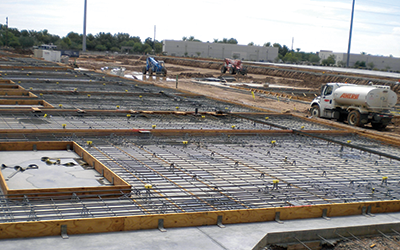
Construction begins on 320,000 square feet of industrial space at Elliot Business Park in Gilbert ©CBRE
Phoenix generally shows strength ahead of other areas of the state. Cassidy Turley’s retail specialist Leavitt has found Phoenix is the leader in bringing new tenants to Arizona, who branch out from here to other cities. And Sundt’s Hedlund has found construction in Phoenix to always start more quickly than the next biggest metropolitan area, Tucson.
Providing perspective from some of Sundt’s other markets, Hedlund shares that California is very busy (“In the public sector, surprisingly.”), spending continues in Texas in both the public and private arenas, and Denver has experienced continual capital spending. “[Colorado’s] cities and state are in better shape than Arizona,” he says, “so there’s been continued funding for colleges and municipalities.”
But Phoenix is also looking good in comparison to other parts of the country. “There’s a significant rebound ahead of [markets] Ryan Companies is operating in elsewhere,” Strittmatter says. “We finally seem to be coming out of the housing problem … and that bodes well, for long term, for our recovery.”
“There are good projects hoping to get legs,” Hedlund says, noting that solid developers who have been through a few of these real estate boom-and-bust cycles put themselves on the sidelines early and are positioning themselves to be on the first wave of the recovery. “They have projects that are shovel-ready and can go quickly if they get the right tenants and funding.” And he sees a lot of demand for people in fields such as geo-technical, civil engineering and title — who get involved in the early contemplation of projects. “It doesn’t mean everything [they work on] will happen, but we’re cautiously optimistic.”


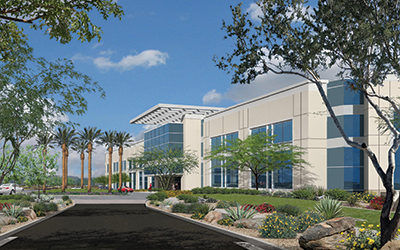












Speak Your Mind
You must be logged in to post a comment.